Can You Use a Cruise Ship as Transportation

Nyk Aphrodite carrying up to 6500 containers

Maritime public passenger transport (Delfino Verde) in Trieste


A container ship belonging to the French shipping line CMA CGM.

Maritime transport (or ocean transport) and hydrolyc effluvial transport, or more than generally waterborne transport, is the send of people (passengers) or goods (cargo) via waterways. Freight transport by sea has been widely used throughout recorded history. The advent of aviation has diminished the importance of sea travel for passengers, though it is still pop for brusque trips and pleasure cruises. Transport by water is cheaper than transport by air,[1] despite fluctuating commutation rates and a fee placed on tiptop of freighting charges for carrier companies known every bit the currency adjustment gene. Maritime send accounts for roughly 80% of international merchandise, according to UNCTAD in 2020.
Maritime ship can be realized over any distance by boat, ship, sailboat or clomp, over oceans and lakes, through canals or forth rivers. Aircraft may be for commerce, recreation, or for military purposes. While all-encompassing inland shipping is less disquisitional today, the major waterways of the earth including many canals are still very important and are integral parts of worldwide economies. Particularly, especially any textile tin be moved past h2o; withal, water transport becomes impractical when material delivery is time-critical such as various types of perishable produce. Still, h2o send is highly cost effective with regular schedulable cargoes, such as trans-oceanic shipping of consumer products – and especially for heavy loads or bulk cargos, such equally coal, coke, ores, or grains. Arguably, the industrial revolution took place best where cheap water transport by canal, navigations, or shipping past all types of watercraft on natural waterways supported price-effective bulk send.
Containerization revolutionized maritime transport starting in the 1970s. "Full general cargo" includes goods packaged in boxes, cases, pallets, and barrels. When a cargo is carried in more than one way, it is intermodal or co-modal.
Clarification [edit]

2005 registration of merchant ships (one,000 gross tonnage (GT) and over) per land.[2]
A nation'due south shipping fleet (merchant navy, merchant marine, merchant armada) consists of the ships operated by civilian crews to send passengers or cargo from one place to another. Merchant shipping also includes water ship over the river and canal systems connecting inland destinations, big and small. For example, during the early mod era, cities in the Hanseatic League began taming Northern Europe's rivers and harbors. Similarly, the Saint Lawrence Seaway connects the port cities on the Great Lakes in Canada and the United States with the Atlantic Ocean shipping routes, while the various Illinois canals connect the Great Lakes and Canada with New Orleans. Ores, coal, and grains can travel forth the rivers of the American Midwest to Pittsburgh or to Birmingham, Alabama. Professional mariners are known as merchant seamen, merchant sailors, and merchant mariners, or simply seamen, sailors, or mariners. The terms "seaman" or "sailor" may besides refer to a member of a land's navy.
According to the 2005 CIA World Factbook, the full number of merchant ships of at least ane,000 gross annals tons in the world was thirty,936. In 2010, it was 38,988, an increase of 26%.[3] As of Dec 2018[update], a quarter of all merchant mariners were born in the Philippines.[four] Statistics for individual countries are available at the list of merchant navy capacity by country.
Liners and tramps [edit]
A ship may also be categorized equally to how it is operated.
- A liner will have a regular run and operate to a schedule. The scheduled operation requires that such ships are meliorate equipped to deal with causes of potential delay such as bad weather condition. They are by and large college powered than tramp ships with better seakeeping qualities, thus they are significantly more expensive to build. Liners are typically congenital for passenger and container operation though past mutual uses besides included mail and general cargo.
- A tramp (trader) has no fixed run just will go wherever a suitable cargo takes it. Thus a ship and crew may be chartered from the ship owner to fetch a cargo of grain from Canada to Latvia, the send may and then be required to bear a cargo of coal from United kingdom of great britain and northern ireland to Melanesia. Bulk carriers and some cruise ships are examples of ships built to operate in this manner.
Ships and watercraft [edit]
Ships and other watercraft are used for maritime ship. Types can be distinguished by propulsion, size or cargo type. Recreational or educational arts and crafts still utilise wind power, while some smaller craft utilize internal combustion engines to drive one or more than propellers, or in the case of jet boats, an inboard water jet. In shallow-draft areas, such equally the Everglades, some craft, such every bit the hovercraft, are propelled by large pusher-prop fans.
Most modern merchant ships tin exist placed in one of a few categories, such as:
| Primary maritime transport types | |
|---|---|
| Image | Description |
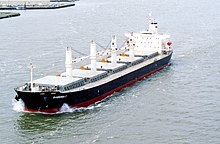 | Majority carriers are cargo ships used to transport bulk cargo items such as ore or food staples (rice, grain, etc.) and similar cargo. They can be recognized past the large box-similar hatches on their deck, designed to slide outboard for loading. A bulk carrier could be either dry or wet. Most lakes are too small to accommodate bulk ships, simply a large fleet of lake freighters has been plying the Great Lakes and St. Lawrence Seaway of North America for over a century. |
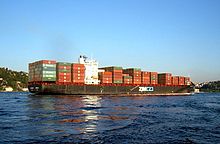 | Container ships are cargo ships that carry their entire load in truck-sized containers, in a technique chosen containerization. They form a common ways of commercial intermodal freight transport. Informally known as "box boats," they carry the majority of the world's dry cargo. Most container ships are propelled by diesel fuel engines and have crews of between ten and 30 people. They more often than not have a large accommodation cake at the stern, directly above the engine room. |
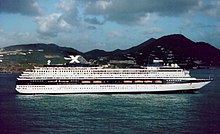 | Cruise ships are rider ships used for pleasure voyages, where the voyage itself and the ship's amenities are considered an essential part of the feel. Cruising has become a major part of the tourism industry, with millions of passengers each year every bit of 2006. The manufacture'south rapid growth has seen nine or more newly congenital ships catering to a North American clientele added every year since 2001, every bit well every bit others servicing European clientele. Smaller markets such as the Asia-Pacific region are generally serviced by older tonnage displaced past new ships introduced into the high growth areas. On the Baltic Sea, ports are continued by cruiseferries. |
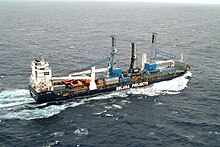 | A multi-purpose ship (sometimes called a full general cargo ship) is used to transport a variety of goods, from bulk commodities to break bulk and heavy cargoes. To provide maximum trading flexibility they are normally geared (supplied with cranes), and mod examples are fitted for the carriage of containers and grains. Mostly they volition have large open holds and tweendecks to facilitate the carriage of dissimilar cargoes on the same voyage. The crew will exist highly competent in the securing of break bulk cargoes and the ship volition exist equipped with various lashings and other equipment for sea fastening. |
 | An ocean liner is a rider ship designed to ship people from ane seaport to another along regular long-distance maritime routes co-ordinate to a schedule. Bounding main liners may also comport cargo or mail, and may sometimes be used for other purposes. Ocean liners are ordinarily strongly built with a high freeboard to withstand rough seas and adverse conditions encountered in the open body of water, having big capacities for fuel, food and other consumables on long voyages. These were the main stay of almost passenger transport companies, however, due to the growth of air travel, the passenger ships saw a steady decline. Cruise ships later filled the void and are primarily used by people who all the same have a dearest of the ocean and offer more civilities than the older passenger ships. |
 | Refrigerated ships (usually chosen reefers) are cargo ships typically used to transport perishable commodities which require temperature-controlled transportation, more often than not fruits, meat, fish, vegetables, dairy products and other foodstuffs. |
 | Ringlet-on/curl-off ships are ships designed to transport wheeled cargo such every bit automobiles, trailers or railway carriages. RORO (or ro/ro) vessels have congenital-in ramps which allow the cargo to be efficiently "rolled on" and "rolled off" the vessel when in port. While smaller ferries that operate across rivers and other short distances notwithstanding often accept built-in ramps, the term RORO is generally reserved for larger ocean-going vessels, including pure automobile/truck carrier (PCTC) ships. |
 | Tankers are cargo ships for the send of fluids, such as crude oil, petroleum products, liquefied petroleum gas (LPG), liquefied natural gas (LNG) and chemicals, as well vegetable oils, wine and other nutrient. The tanker sector comprises one third of the world tonnage. |
| Secondary maritime send types | |
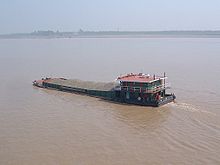 | A clomp is a flat-bottomed boat, built mainly for river and canal transport of heavy goods. Near barges are non cocky-propelled and demand to be moved by tugboats towing or towboats pushing them. Barges on canals (towed by draft animals on an adjacent towpath) established the conditions supporting the early on industrial revolution in both Europe and the American Northeast just afterwards after they made possible steam locomotive prime number movers riding iron runway – after both could grow (and mature) to become commonplace and capable – contended with the railways and were outcompeted in the railroad vehicle of people, low-cal freight, and high value items due to the higher speed, falling costs, and route flexibility of rail transport. Carriage of bulk goods too gradually lost ground to freight railways equally train capacity and speeds connected to climb. Even underpowered early rail networks could usually attain places only an outrageously expensive canal might be built,[5] and once Atomic number 26 T-rail and higher powered locomotives became possible, the far cheaper to build railways were unfettered and contained upon water sources, whilst mostly unplagued by the seasonal problems (restricted by icing) of temperate latitude canals which suffered ice and freshet flooding damages with dreary regularity. When floods did affect railways, restoration of services was usually comparatively rapid. |
 | Cablevision layer is a deep-bounding main vessel designed and used to lay underwater cables for telecommunications, electricity, and such. A large superstructure, and one or more spools that feed off the transom distinguish it. |
 | Littoral trading vessels, also known as coasters, ships used for merchandise between locations on the same island or continent. They are ofttimes small and of shallow draft, and sometimes set up as self-dischargers. |
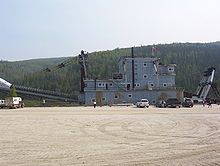 | A dredger (sometimes too chosen a dredge) is a transport used to excavate in shallow seas or fresh h2o areas with the purpose of gathering up lesser sediments and disposing of them at a dissimilar location. |
 | Ferries are a grade of send, usually a gunkhole or ship, only also other forms, carrying (or ferrying) passengers and sometimes their vehicles. Ferries are also used to send freight (in lorries and sometimes unpowered freight containers) and even railroad cars. Nigh ferries operate on regular, frequent return services. A pes-passenger ferry with many stops is sometimes called a waterbus or water taxi. Ferries form a office of the public send systems of many waterside cities and islands, allowing direct transit between points at a capital price much lower than bridges or tunnels. Many of the ferries operating in Northern European waters are curl-on/roll-off ships. |
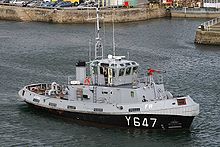 | A tugboat is a boat used to manoeuvre, primarily by towing or pushing, other vessels (see shipping) in harbours, over the open ocean or through rivers and canals. They are as well used to tow barges, disabled ships, or other equipment like towboats. |
 | Open hatch general cargo ships are designed to transport forest products, bulk cargos, unitized cargoes, projection cargoes and containers. |
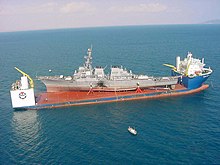 | Semi-submersible heavy-lift ships often movement particularly large, heavy, or bulky goods that other ships cannot handle well. Such off-size goods include ship hulls, premade construction materials, other seagoing vessels, power plant components, cast steel objects, and a diverseness of very big or heavy goods. |
Typical in-transit times [edit]
A cargo send sailing from a European port to a Us i will typically take 10–12 days depending on water currents and other factors.[six] In order to brand container transport transport more economical in the face of declining need for intercontinental shipping, ship operators sometimes reduce cruising speed, thereby increasing transit time, to reduce fuel consumption, a strategy referred to as "deadening steaming".[vii]
History [edit]
| | This section needs expansion. You tin can help past adding to it. (July 2021) |
Professional mariners [edit]

This map of aircraft routes illustrates the relative density of commercial shipping in the globe's oceans.
A ship's complement can be divided into 4 categories:
- The deck department
- The engine department
- The steward's department
- Other.
Deck department [edit]
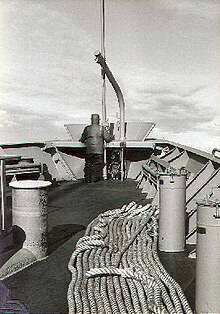
An able seaman stands iceberg picket on the bow of the freighter USNS Southern Cross during a re-supply mission to McMurdo Station, Antarctica; circa 1981.
Officer positions in the deck department include but not express to the Master and his Chief, Second, and Third officers. The official classifications for unlicensed members of the deck department are Able Seaman and Ordinary Seaman.
A common deck coiffure for a ship includes:
- (1) Chief Officeholder/Primary Mate
- (i) Second Officer/Second Mate
- (i) 3rd Officer/Third Mate
- (i) Boatswain
- (two–vi) Able Seamen
- (0–2) Ordinary Seamen
A deck cadet is a person who is carrying out mandatory sea fourth dimension to accomplish their officer of the watch certificate. Their time on lath is spent learning the operations and tasks of everyday life on a merchant vessel.
Engine section [edit]
A ship's engine department consists of the members of a ship's crew that operate and maintain the propulsion and other systems on board the vessel. Engine staff also deal with the "Hotel" facilities on board, notably the sewage, lighting, air conditioning and h2o systems. They deal with bulk fuel transfers, and require grooming in firefighting and starting time aid, as well every bit in dealing with the ship'southward boats and other nautical tasks- peculiarly with cargo loading/discharging gear and safety systems, though the specific cargo belch role remains the responsibleness of deck officers and deck workers. On LPG and LNG tankers, however, a cargo engineer works with the deck department during cargo operations, as well as being a watchkeeping engineer.
A common engine crew for a ship includes:
- (1) Primary engineer
- (one) Second engineer / first banana engineer
- (i) Third engineer / second assistant engineer
- (1 or 2) Fourth engineer / third banana engineer
- (0–2) Fifth engineer / junior engineer
- (one–3) Oiler (unlicensed qualified rating)
- (0–3) Greaser (unlicensed qualified rating)
- (i–5) Entry-level rating (such as wiper (occupation), utilityman, etc.)
Many American ships also carry a motorman. Other possible positions include machinist, electrician, refrigeration engineer, and tankerman. Engine cadets are engineer trainees who are completing sea time necessary earlier they tin can obtain a watchkeeping license.
Steward's department [edit]
A typical steward'south department for a cargo ship would be equanimous of a Chief Steward, a Chief Melt, and a Steward's Assistant. All three positions are typically filled by unlicensed personnel. The chief steward directs, instructs, and assigns personnel performing such functions equally preparing and serving meals; cleaning and maintaining officers' quarters and steward department areas; and receiving, issuing, and inventorying stores. On large passenger vessels, the Catering Section is headed by the Chief Purser and managed by Assistant Pursers. Although they enjoy the benefits of having officer rank, they generally progress through the ranks to become pursers. Under the pursers are the section heads – such as chief cook, head waiter, head barman etc. They are responsible for the administration of their own areas.
The chief steward also plans menus and compiles supply, overtime, and price command records. They may requisition or purchase stores and equipment. They may bake bread, rolls, cakes, pies, and pastries. A principal steward'southward duties may overlap with those of the Steward's Assistant, the Chief Melt, and other Steward'southward Department crewmembers.
In the The states Merchant Marine, a chief steward must have a Merchant Mariner'due south Document issued by the United states of america Coast Guard. Because of international law, conventions, and agreements, all principal cooks who sail internationally are similarly documented by their respective countries.
Other departments [edit]
Staff officer positions on a ship, including Junior Assistant Purser, Senior Assistant Purser, Purser, Chief Purser, Medical Doctor, Professional person Nurse, Marine Physician Assistant, and Infirmary Corpsman, are considered administrative positions and are therefore regulated past Certificates of Registry issued by the U.s.a. Declension Guard. Pilots are also merchant marine officers and are licensed by the Declension Guard. Formerly, in that location was besides a radio section, headed by a chief radio officer and supported by a number of radio officers. Since the introduction of GMDSS (Satellite communications) and the subsequent exemptions from carrying radio officers if the vessel is so equipped, this department has fallen away, although many ships do yet comport specialist radio officers, particularly passenger vessels. Many radio officers became 'electro-technical officers', and transferred into the engine section.
Life at bounding main [edit]
Mariners spend much of their life beyond the reach of land. They sometimes face dangerous weather condition at sea or on lakes – the fishing port of Gloucester, Massachusetts has a seaside memorial listing over 10,000 fishermen who lost their lives to the bounding main, and the Great Lakes have seen over 10,000 lost vessels since the 1800s, even so men and women even so get to sea. For some, the allure is a life unencumbered with the restraints of life ashore. Seagoing chance and a chance to see the world also appeal to many seafarers. Whatever the calling, those who live and piece of work at body of water invariably confront social isolation.
Findings by the Seafarer's International Enquiry Eye indicate a leading cause of mariners leaving the manufacture is "almost invariably considering they want to be with their families." U.Due south. merchant ships typically do not let family members to accompany seafarers on voyages. Industry experts increasingly recognize isolation, stress, and fatigue equally occupational hazards. Advocacy groups such as International Labour Organization, a United nations agency, and the Nautical Institute are seeking improved international standards for mariners.[8] [9] Satellite phones accept improved advice and efficiency aboard sea-faring ships. This technology has contributed to crew welfare, although both equipment and fees are expensive.[10]
Ocean voyages are steeped in routine. Maritime tradition dictates that each day exist divided into vi four-hour periods. 3 groups of watch keepers from the engine and deck departments work 4 hours on then have eight hours off spotter keeping. Still, at that place are many overtime jobs to be washed daily. This cycle repeats endlessly, 24 hours a day while the ship is at bounding main. Members of the steward department typically are twenty-four hour period workers who put in at least eight-hour shifts. Operations at sea, including repairs, safeguarding against piracy, securing cargo, underway replenishment, and other duties provide opportunities for overtime work. Service aboard ships typically extends for months at a fourth dimension, followed by protracted shore go out. Even so, some seamen secure jobs on ships they like and stay aboard for years.
The quick turnaround of many modern ships, spending only a few hours in port, limits a seafarer's gratis-fourth dimension ashore. Moreover, some foreign seamen inbound U.S. ports from a picket listing of 25 countries confront restrictions on shore exit due to maritime security concerns. However, shore leave restrictions while in U.S. ports impact American seamen as well. For case, the International Organization of Masters, Mates & Pilots notes a trend of U.S. shipping terminal operators restricting seamen from traveling from the send to the last gate. Furthermore, in cases where transit is allowed, special "security fees" are at times assessed.
Such restrictions on shore go out, coupled with reduced time in port, translate into longer periods at sea. Mariners report that extended periods at bounding main living and working with shipmates, who for the most role are strangers, takes getting used to. At the same fourth dimension, at that place is an opportunity to meet people from other ethnic and cultural backgrounds. Recreational opportunities accept improved aboard some U.S. ships, which may feature gyms and twenty-four hour period rooms for watching movies, swapping sea stories, and other activities. And in some cases, especially tankers, it is possible for a mariner to exist accompanied by members of his family unit. However, a mariner's off-duty time is largely a solitary matter, pursuing hobbies, reading, writing letters, and sleeping.
On modernistic sea-going vessels, typically registered with a flag of convenience, life has changed immensely in the last 20 years. Most large vessels include a gym and often a swimming pool for use past the coiffure. Since the Exxon Valdez incident, the focus of leisure fourth dimension activity has shifted from having officeholder and crew confined, to simply having lounge-style areas where officers or crew can sit to watch movies. With many companies at present providing TVs and DVD players in cabins, and enforcing strict smoking policies, it is not surprising that the bar is now a much quieter place on near ships. In some instances games consoles are provided for the officers and crew. The officers relish a much higher standard of living on board body of water-going vessels.
Crews are generally poorly paid, poorly qualified and accept to complete contracts of approximately 9 months before returning home on leave. They oft come from countries where the average industrial wage is even so very low, such as the Philippines or India. Officers however, come from all over the world and information technology is not uncommon to mix the nationality of the officers on board ships. Officers are often the recipients of university degrees and have completed vast amounts of training in order to reach their rank. Officers benefit east.grand. past having larger, more comfy cabins and table service for their meals.
Contracts average at the 4 calendar month mark for officers, with generous leave. Virtually bounding main-going vessels now operate an unmanned engine room organisation allowing engineers to work days just. The engine room is computer controlled by night, although the duty engineer will make inspections during unmanned performance. Engineers work in a hot, humid, noisy atmosphere. Communication in the engine room is therefore by hand signals and lip-reading, and good teamwork frequently stands in place of whatever advice at all.
Environmental impact [edit]
The ecology impact of shipping includes greenhouse gas emissions, acoustic, and oil pollution.[eleven] The International Maritime Organization (IMO) estimates that Carbon dioxide emissions from shipping were equal to two.2% of the global human-fabricated emissions in 2012[12] and expects them to rise 50 to 250 pct by 2050 if no activeness is taken.[xiii]
Infrastructure [edit]

For a port to efficiently send and receive cargo, information technology requires infrastructure: docks, bollards, pilings, cranes, bulk cargo handling equipment, and then on – equipment and system supporting the role of the facilities. From pier to pier these may differ, one dock handling intermodal send needs (container-ships linked to rail past cranes); another bulk treatment capabilities (such as conveyors, elevators, tanks, pumps) for loading and unloading bulk cargoes similar grain, coal, or fuels. Others may exist outfitted as passenger terminals or for mixed mode operations.
Generally, Harbors, seaports and marinas all host watercraft, and consist of components such equally piers, wharfs, docks and roadsteads.
See also [edit]
- Electric ship
- European Marriage aircraft police force
- Glossary of nautical terms
- Listing of cargo types
- List of maritime colleges
- Listing of merchant marine capacity by state
- List of sailors
- List of send companies
- Lloyd'southward War Medal for Bravery at Bounding main
- The Marine Order
- Maritime history
- Maritime safety
- Merchant vessel
- MV Yara Birkeland
- Navigation
- Navigability
- Shipping line
- SIGTTO
- UNCTAD review of maritime transport
- Waterway
- Send watching
Notes [edit]
- ^ Stopford, Martin (1997-01-01). Maritime Economics. Psychology Printing. p. 10. ISBN9780415153102.
- ^ "Rank Order - Merchant marine". CIA.gov . Retrieved 2007-05-21 .
- ^ "The World Factbook — Key Intelligence Bureau". world wide web.cia.gov.
- ^ Almendral, Aurora (December 2018). "Why 10 1000000 Filipinos suffer hardship abroad as overseas workers". National Geographic. The states. Retrieved 2 March 2019.
"Unsung Filipino seafarers power the global economic system". The Economist. 16 February 2019. Retrieved 2 March 2019.
Kale Bantigue Fajardo. Filipino Crosscurrents: Oceanographies of Seafaring, Masculinities, and Globalization. Academy of Minnesota Press. ISBN978-1-4529-3283-5. - ^ See Philadelphia and Columbia Railroad; was built because a Philadelphia to Susquehanna River canal would've needed a large water source requiring very expensive works to supply; canals without h2o are just a dingy ditch.
- ^ "Service Details". cms.molpower.com . Retrieved 2015-07-29 .
- ^ Inti Landauro (January 8, 2013), "Meet the Globe's Largest Cargo Ships", The Wall Street Journal (paper), p. B1
- ^ "Maritime Labour Convention". world wide web.ilo.org. International Labour System. 23 Feb 2006. Retrieved 2015-07-29 .
- ^ Turner, Faye. "Aims and Objectives". www.nautinst.org. The Nautical Plant. Retrieved 2015-07-29 .
- ^ Ioannis Theotokas, Aimilia Papachristou, Alexandros Koukoravas and Damian Stanchev, "Go-Maritime.net"
- ^ Walker TR, Adebambo O, Del Aguila Feijoo MC, Elhaimer E, Hossain T, Edwards SJ, Morrison CE, Romo J, Sharma N, Taylor South, Zomorodi S (2019). "Ecology Effects of Marine Transportation". World Seas: An Environmental Evaluation. pp. 505–530. doi:10.1016/B978-0-12-805052-1.00030-nine. ISBN978-0-12-805052-one.
- ^ Third IMO GHG Study 2014 (PDF), International Maritime Organisation
- ^ 2nd IMO GHG Study 2014 (PDF), International Maritime Organization, archived from the original (PDF) on 2015-10-19
References [edit]
- Office of Data and Economical Assay (July 2006). "World Merchant Fleet 2001–2005" (PDF). United States Maritime Assistants. Archived from the original (PDF) on February 21, 2007. Retrieved March thirteen, 2007.
- Thompson, Mark L. (1994). Queen of the Lakes. ISBN0-8143-2393-half-dozen.
- Un Council on Trade and Development (UNCTAD) (2005). Review of Maritime Transport, 2005. New York and Geneva: United nations. Archived from the original on 2008-05-xiii.
- United Nations Council on Trade and Development (UNCTAD) (2006). Review of Maritime Transport, 2006 (PDF). New York and Geneva: United Nations.
- Wijnolst, Niko; Wergeland, Tor (2009). Shipping innovation. Amsterdam: IOS Press. ISBN978-1-58603-943-one.
- UNCTAD (2020). Review of Maritime Transport 2020. Retrieved from: https://unctad.org/topic/transport-and-merchandise-logistics/review-of-maritime-transport
External links [edit]
- MarineTraffic: Global Ship Tracking Intelligence
Source: https://en.wikipedia.org/wiki/Maritime_transport
0 Response to "Can You Use a Cruise Ship as Transportation"
Publicar un comentario